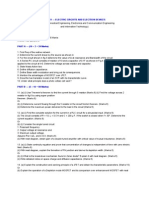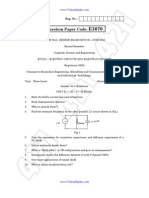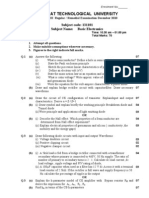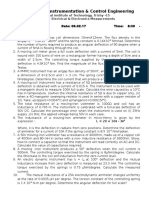Question Paper Code:: Reg. No.
Question Paper Code:: Reg. No.
Uploaded by
Bala SubramanianCopyright:
Available Formats
Question Paper Code:: Reg. No.
Question Paper Code:: Reg. No.
Uploaded by
Bala SubramanianOriginal Description:
Original Title
Copyright
Available Formats
Share this document
Did you find this document useful?
Is this content inappropriate?
Copyright:
Available Formats
Question Paper Code:: Reg. No.
Question Paper Code:: Reg. No.
Uploaded by
Bala SubramanianCopyright:
Available Formats
w
w
w
.
r
e
j
i
n
p
a
u
l
.
c
o
m
w
w
w
.
r
e
j
i
n
p
a
u
l
.
c
o
m
Reg. No. :
B.E./B.Tech. DEGREE EXAMINATION, JUNE 2010
Second Semester
Computer Science and Engineering
EC2151 ELECTRIC CIRCUITS AND ELECTRON DEVICES
(Regulation 2008)
(Common to Biomedical Engineering, Electronics and Communication Engineering
and Information Technology)
Time : Three hours Maximum : 100 Marks
Answer ALL Questions
PART A (10 2 = 20 Marks)
1. State Kirchoffs current law and voltage law.
2. State Superposition theorem.
3. What is quality factor?
4. Find the resonant frequency in the ideal parallel LC circuit shown in Fig.1
Fig.1.
5. Give the expression for transition capacitance and diffusion capacitance of a
PN diode.
6. Define avalanche break down?
7. What is Early effect in CB configuration and give its consequences?
8. Distinguish clearly the difference between N with P channel FETs.
9. Give some applications of tunnel diode.
10. What is meant by photovoltaic cell?
Question Paper Code: E3070
www.rejinpaul.com
www.rejinpaul.com
w
w
w
.
r
e
j
i
n
p
a
u
l
.
c
o
m
w
w
w
.
r
e
j
i
n
p
a
u
l
.
c
o
m
E 3070 2
PART B (5 16 = 80 Marks)
11. (a) (i) State Thevenins and superposition theorems, mention one
application. (8)
(ii) Find the Thevenins equivalent of the circuit shown in Fig. 2. (8)
Fig.2
Or
(b) (i) Consider the circuit in Fig. 3. (12)
Fig. 3
(1) If Rout = 3 k, find the power delivered to it.
(2) What is the maximum power that can be delivered to any Rout?
(3) What two different values of Rout will have exactly 20mw
delivered to them?
(ii) State maximum power transfer theorem. (4)
12. (a) In the circuit shown in Fig. 4, determine the complete solution for the
current when the switch is closed at t = 0. Applied voltage is
) 4 / 500 cos( 400 v(t) + = t , resistance R = 15 , inductance H L 2 . 0 =
and capacitance F C 3 = . (16)
Fig. 4
Or
www.rejinpaul.com
www.rejinpaul.com
w
w
w
.
r
e
j
i
n
p
a
u
l
.
c
o
m
w
w
w
.
r
e
j
i
n
p
a
u
l
.
c
o
m
E 3070 3
(b) (i) Explain (using the relevant circuit) the double tuned circuit and
derive the expression for A and Mc. (10)
(ii) The tuned frequency of a double tuned circuit shown in Fig.5 is
10
4
rad/sec. If the source voltage is 2 v and has a resistance of
0.1 , calculate the maximum output voltage at resonance if
= 01 . 0
1
R , H L 2
1
= , = 1 . 0
2
R and H L 25
2
= . (6)
Fig. 5
13. (a) (i) Derive the PN diode current equation. (8)
(ii) Explain how the depletion region at a p-n junction is formed and
explain with relevant sketches for charge density, electric field
intensity and potential energy barriers at the junction. (8)
Or
(b) (i) Draw the Zener diode characteristics and explain the working of
Zener diode. (8)
(ii) Draw the Zener regulation circuit and explain its function for input
regulation and output regulation. (8)
14. (a) Explain the input and output characteristics of a common emitter
configuration with a neat sketch. (16)
Or
(b) What is MOSFET? Explain the construction and working principle of
enhancement mode and depletion mode MOSFET with a neat diagram.
(16)
15. (a) What is tunneling phenomenon? Describe the V-I characteristics and
concepts of tunnel diode with application. (16)
Or
(b) Explain the negative resistance characteristics of Unijunction Transistor
with neat sketch. (16)
www.rejinpaul.com
www.rejinpaul.com
You might also like
- EDC Question-Papers Complete SetDocument13 pagesEDC Question-Papers Complete Setselvi04120% (1)
- EC Question PaperDocument3 pagesEC Question PaperGna Senthil KumarNo ratings yet
- Electronic Devices and Circuits Nov/dec2009Document3 pagesElectronic Devices and Circuits Nov/dec2009Raj KumarNo ratings yet
- Ec2151-Electronic Circuits and Electron Devices-R8 2010Document3 pagesEc2151-Electronic Circuits and Electron Devices-R8 2010Leka AmuNo ratings yet
- Electric Circuits &electronics Device Question PaperDocument5 pagesElectric Circuits &electronics Device Question PaperSalai Kishwar JahanNo ratings yet
- Time: Three Hours Answer ALL Questions Max Marks:100Document2 pagesTime: Three Hours Answer ALL Questions Max Marks:100Vijayalakshmi VijiNo ratings yet
- 5 EC 2151 - Electric Circuits and Electronic DevicesDocument3 pages5 EC 2151 - Electric Circuits and Electronic DevicesBIBIN CHIDAMBARANATHANNo ratings yet
- Question Paper Code:: Reg. No.Document6 pagesQuestion Paper Code:: Reg. No.sunil1237No ratings yet
- Electric Circuits and Electron Devices Unit I Circuit Analysis Techniques Part-ADocument8 pagesElectric Circuits and Electron Devices Unit I Circuit Analysis Techniques Part-ASalai Kishwar JahanNo ratings yet
- Question Paper Code:: Reg. No.Document0 pagesQuestion Paper Code:: Reg. No.aishuvc1822No ratings yet
- Model Exam BDocument4 pagesModel Exam BsugunapriyaaaNo ratings yet
- EST QuestionDocument3 pagesEST QuestionashNo ratings yet
- Analysis of Circuits June-10Document6 pagesAnalysis of Circuits June-10praveenhari92No ratings yet
- ELECTRICAL CIRCUITS SyllabusDocument8 pagesELECTRICAL CIRCUITS SyllabusShareef KhanNo ratings yet
- L-1, T-2, EEE, 2018-2019 (Online)Document18 pagesL-1, T-2, EEE, 2018-2019 (Online)Test DriverNo ratings yet
- WWW - Studyhaunters.blogspot - In: Question Paper Code: 22115Document5 pagesWWW - Studyhaunters.blogspot - In: Question Paper Code: 22115Sriram JNo ratings yet
- Question Paper Code: 22115: B.E./B.Tech - Degree Examinations, April/May 2011 Regulations 2008Document5 pagesQuestion Paper Code: 22115: B.E./B.Tech - Degree Examinations, April/May 2011 Regulations 2008Vinodh GanesanNo ratings yet
- May 2012Document8 pagesMay 2012satya_vanapalli3422No ratings yet
- I Es Conventional Paper Electrical 1987Document6 pagesI Es Conventional Paper Electrical 1987Alind DubeyNo ratings yet
- IES CONV Electronic Comm. 1998Document9 pagesIES CONV Electronic Comm. 1998gateandiesNo ratings yet
- Ese 88Document8 pagesEse 88Prasanna KumarNo ratings yet
- Network Analysis and Synthesis QBDocument11 pagesNetwork Analysis and Synthesis QBGowthamNo ratings yet
- Edc 4Document10 pagesEdc 429viswa12No ratings yet
- IES 1988 Question PaperpdfDocument8 pagesIES 1988 Question Paperpdfh9emanth4No ratings yet
- Edc 3Document10 pagesEdc 329viswa12No ratings yet
- IES-CONV-Electrical Engineering 1994 PDFDocument9 pagesIES-CONV-Electrical Engineering 1994 PDFvineethkbNo ratings yet
- IES CONV Electronic& Comm. 1980Document6 pagesIES CONV Electronic& Comm. 1980Sohil VohraNo ratings yet
- Gujarat Technological University: InstructionsDocument2 pagesGujarat Technological University: InstructionsjayswamiiNo ratings yet
- Revision Modern Physics.Document2 pagesRevision Modern Physics.chiragsinghania001No ratings yet
- 16 131101 Basic ElectronicsDocument2 pages16 131101 Basic Electronicsdhvani5988No ratings yet
- Civil Services - Electrical Main Paper I & II - 1992-2012 - 7.6MBDocument253 pagesCivil Services - Electrical Main Paper I & II - 1992-2012 - 7.6MBAnika DixitNo ratings yet
- IES Conventional Electronics 2013Document32 pagesIES Conventional Electronics 2013Debi Prasad DashNo ratings yet
- SemiconductorDocument8 pagesSemiconductorchhabrarudra5No ratings yet
- Electrical Circuits Analysis 6Document11 pagesElectrical Circuits Analysis 629viswa12No ratings yet
- Edc 7Document8 pagesEdc 729viswa12100% (1)
- AEC BankDocument9 pagesAEC Bankprakashkerur100% (1)
- aec qbDocument9 pagesaec qbkamatarjeevan2002No ratings yet
- bt21R0718 p1 18 11 09rahulDocument30 pagesbt21R0718 p1 18 11 09rahulAnonymous nTxB1EPvNo ratings yet
- Question Paper Code:: (10 2 20 Marks)Document5 pagesQuestion Paper Code:: (10 2 20 Marks)Samraj JebasinghNo ratings yet
- Prework Questions For KI-1Document5 pagesPrework Questions For KI-1Danial SadiqNo ratings yet
- Pe 2Document4 pagesPe 2Vaibhav YadavNo ratings yet
- 5 EE 2151 - Circuit TheoryDocument4 pages5 EE 2151 - Circuit TheoryBIBIN CHIDAMBARANATHANNo ratings yet
- IoTMumbai_ECN_QB-UT1_final_070818Document4 pagesIoTMumbai_ECN_QB-UT1_final_070818rathodvikas0777No ratings yet
- Model Question Paper Power Electronics: Sub code:-06EE45Document3 pagesModel Question Paper Power Electronics: Sub code:-06EE45GuruprasadNo ratings yet
- r05010401 Network AnalysisDocument15 pagesr05010401 Network AnalysisajachyNo ratings yet
- Question Paper Code:: Reg. No.Document0 pagesQuestion Paper Code:: Reg. No.aishuvc1822No ratings yet
- BEE Q.Paper 2020-21Document2 pagesBEE Q.Paper 2020-21sarwath sultanaNo ratings yet
- Electronics IDocument2 pagesElectronics ISouhardya MukherjeeNo ratings yet
- II B.Tech II Semester, Regular Examinations, April - 2012 Electrical Circuit Analysis - IiDocument8 pagesII B.Tech II Semester, Regular Examinations, April - 2012 Electrical Circuit Analysis - IiViswa ChaitanyaNo ratings yet
- E2101ADocument14 pagesE2101AnotwynnkohNo ratings yet
- Basic Electrical & Electronics Engineering (6 Yrs FRM Jan 02)Document23 pagesBasic Electrical & Electronics Engineering (6 Yrs FRM Jan 02)Jay PandyaNo ratings yet
- Rr-10205-Edc Apr 2003Document8 pagesRr-10205-Edc Apr 2003mpssassygirlNo ratings yet
- Assignment BEE CompleteDocument5 pagesAssignment BEE CompleteHarshit YadavNo ratings yet
- r05010203 Electrical CircuitsDocument14 pagesr05010203 Electrical CircuitsSRINIVASA RAO GANTANo ratings yet
- Organic Light-Emitting Transistors: Towards the Next Generation Display TechnologyFrom EverandOrganic Light-Emitting Transistors: Towards the Next Generation Display TechnologyNo ratings yet
- Fundamentals of Electronics 1: Electronic Components and Elementary FunctionsFrom EverandFundamentals of Electronics 1: Electronic Components and Elementary FunctionsNo ratings yet
- Electromagnetic Compatibility (EMC) Design and Test Case AnalysisFrom EverandElectromagnetic Compatibility (EMC) Design and Test Case AnalysisNo ratings yet
- Power System Transient Analysis: Theory and Practice using Simulation Programs (ATP-EMTP)From EverandPower System Transient Analysis: Theory and Practice using Simulation Programs (ATP-EMTP)No ratings yet
- Impedance Spectroscopy: Theory, Experiment, and ApplicationsFrom EverandImpedance Spectroscopy: Theory, Experiment, and ApplicationsEvgenij BarsoukovNo ratings yet
- Department of Instrumentation & Control EngineeringDocument3 pagesDepartment of Instrumentation & Control EngineeringBala SubramanianNo ratings yet
- Assignment 1 PDFDocument3 pagesAssignment 1 PDFBala Subramanian50% (2)
- IC102 Engineering Mechanics-I-year SyllabusDocument1 pageIC102 Engineering Mechanics-I-year SyllabusBala SubramanianNo ratings yet
- Department of Instrumentation & Control EngineeringDocument3 pagesDepartment of Instrumentation & Control EngineeringBala SubramanianNo ratings yet
- Concentration CellsDocument12 pagesConcentration CellsBala Subramanian100% (3)































































